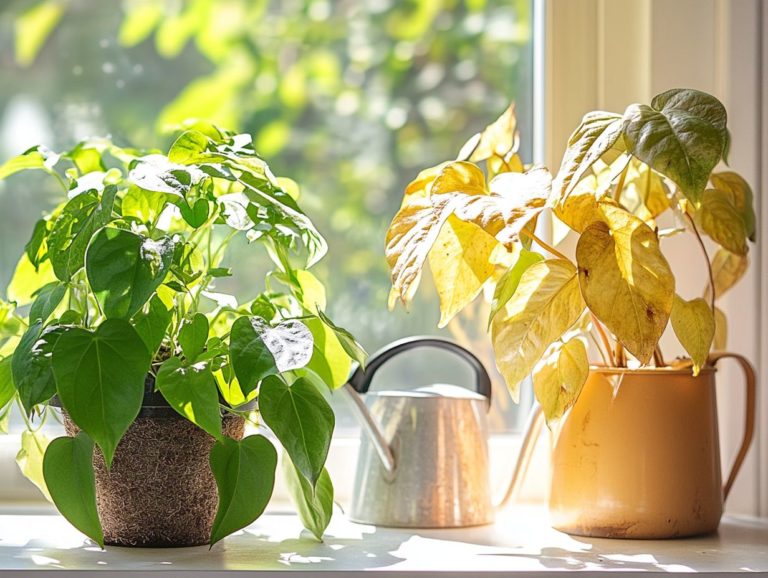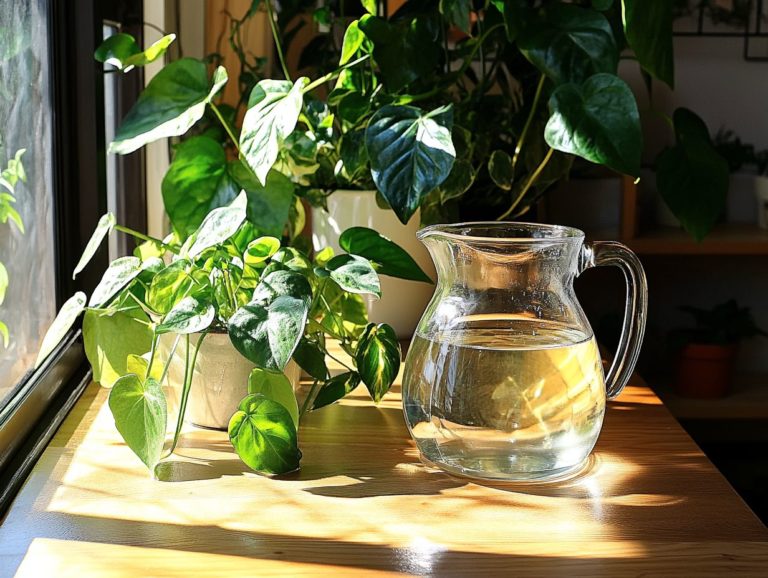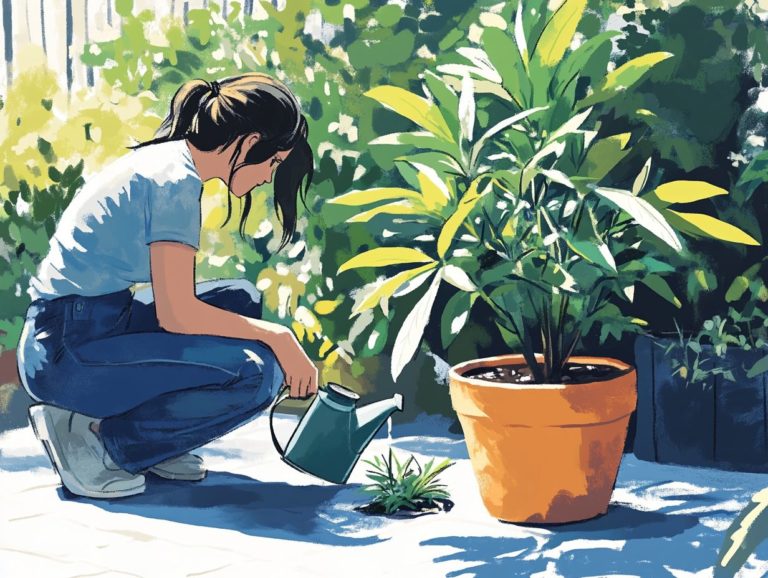Watering Techniques for Different Indoor Species
Indoor plants can bring life to any space. Understanding their watering needs is essential for keeping them healthy.
This guide covers the factors that influence watering requirements. You’ll learn how to care for succulents, leafy plants, and flowering varieties.
Recognizing the signs of over-watering and under-watering will help your plants thrive.
Contents
- Key Takeaways:
- Understanding Watering Needs of Indoor Plants
- Watering Techniques for Succulents
- Watering Techniques for Leafy Plants
- Watering Techniques for Flowering Plants
- Signs of Over and Under-Watering
- Frequently Asked Questions
- What are the best watering techniques for succulents?
- How often should I water my ferns and other indoor plants?
- Is it better to water cacti from the top or bottom, and what about other houseplants?
- What is the best time of day to water indoor plants?
- How can I tell if I am overwatering my indoor plants or underwatering them?
- Do different indoor species like air plants, Dracaena marginata, and others have different watering needs?
Key Takeaways:
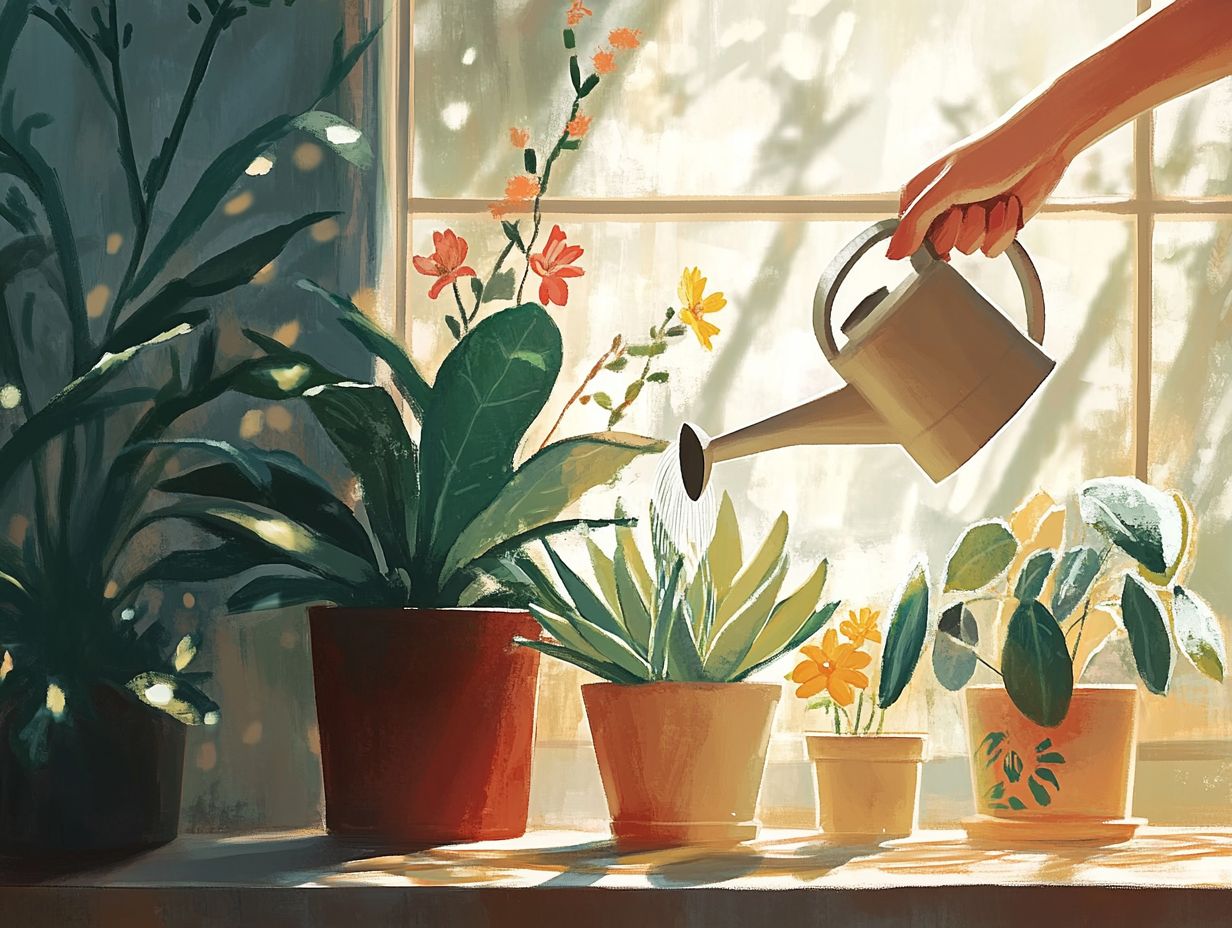
- Understanding watering needs is key to plant survival.
- Succulents need less water; water them from below to avoid rotting.
- Water leafy plants at the soil level, keeping the leaves dry to prevent fungus.
Understanding Watering Needs of Indoor Plants
Knowing your plants’ watering needs is crucial for a successful indoor garden. Each type has its own specific requirements.
Consider factors like soil quality, humidity, temperature, and plant characteristics. These all influence how much and how often you should water.
Using a moisture meter is helpful. It lets you monitor soil moisture and adjust your watering schedule accordingly.
This way, your houseplants receive just the right amount of water they need to thrive.
Factors Affecting Watering Requirements
Several factors play a crucial role in determining your houseplants’ watering needs. These include soil composition, humidity, temperature, and drainage holes in your pots.
The type of soil affects moisture retention and root health. Sandy soils drain quickly, so you ll need to water more often for plants like succulents.
In contrast, clay soils can hold too much water, which is bad for sensitive varieties.
Humidity and temperature also affect a plant s ability to absorb moisture. Humid conditions are great for tropical plants like pothos and peace lilies.
On the other hand, drier conditions may require more attention for plants like snake plants, which are more resilient to lower humidity.
Understanding these dynamics can significantly boost your plant health.
Watering Techniques for Succulents
Watering succulents requires a careful method. These plants can store water in their leaves, and they thrive with specific watering schedules.
Understanding under-watering and over-watering is vital. Both can impact their health and growth significantly.
By using effective strategies, like a moisture meter to check soil moisture or adjusting pot size, you can improve your care routine for succulents.
This ensures they thrive under your care.
Best Practices for Succulent Care
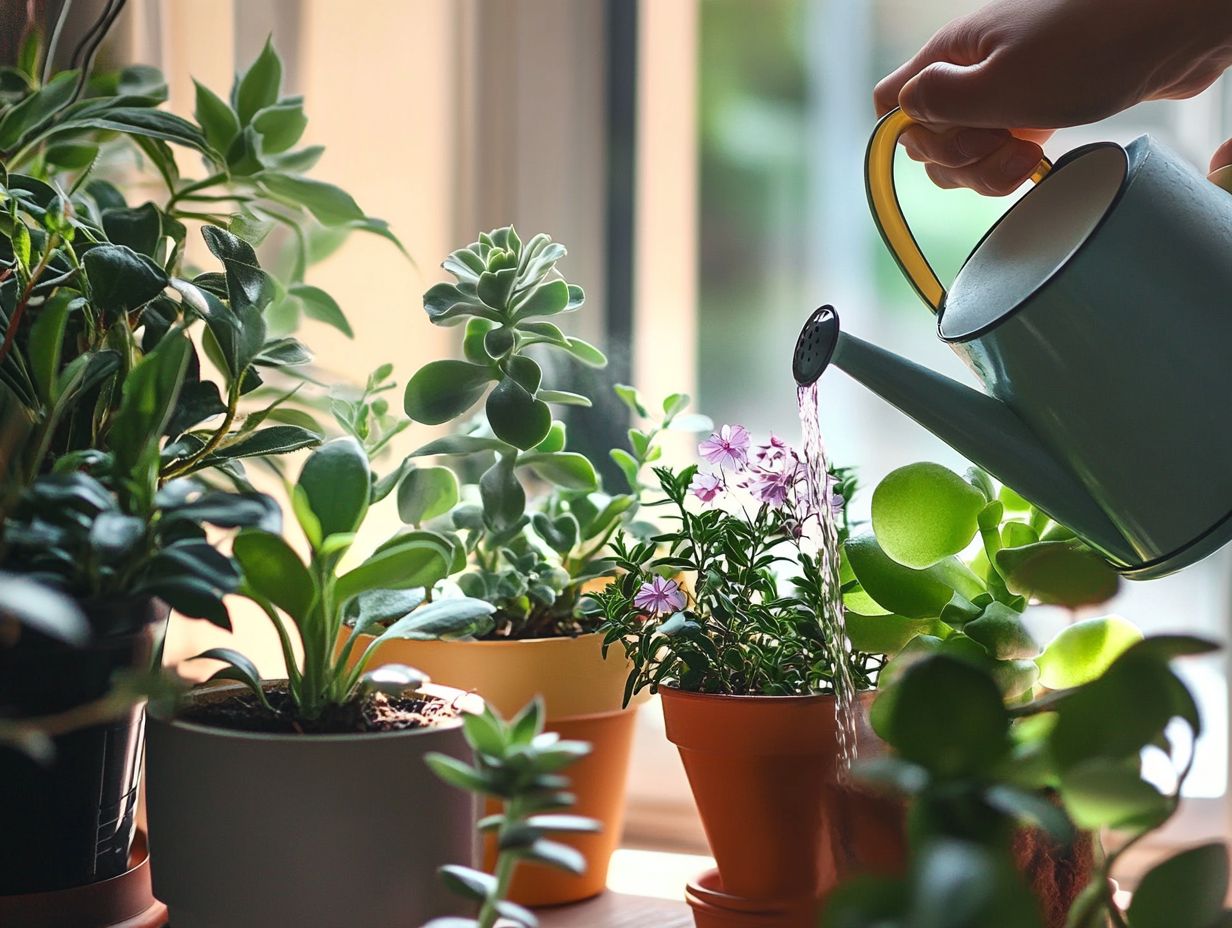
To ensure optimal growth, your best practices for succulent care should focus on appropriate watering techniques, selecting the right pot size, and utilizing essential tools like a watering can for effective moisture delivery.
These practices also involve choosing a well-draining soil mix specifically designed for succulents. This prevents root rot and fosters healthy growth. Ensure your pots have drainage holes to prevent excess water buildup.
Adjusting your care routines based on the plant’s light conditions can enhance their vitality. For example, you may need to increase watering for succulents positioned in brighter spots or during the warmer months.
Using tools like moisture meters, which measure the moisture level in the soil, can help you determine when it’s time to water. Setting reminders on your calendar can help maintain a consistent watering schedule. Don’t wait too long to check your plants!
Watering Techniques for Leafy Plants
When watering leafy plants, a discerning strategy is essential. These houseplants thrive on regular watering schedules tailored to their specific moisture and humidity needs.
Considerations like room temperature, leaf size, and overall plant health play pivotal roles in determining how and when to water. It’s essential to monitor conditions diligently.
Different species, such as Dracaena marginata and Golden Pothos, require unique watering approaches. This helps promote lush foliage and vigorous growth.
Proper Watering for Leafy Plants
Proper watering for your leafy plants is crucial to avoid under-watering or over-watering, both of which can stifle healthy growth or even lead to plant demise.
Recognizing moisture imbalance is crucial for keeping your plants thriving. An under-watered plant may show droopy or curled leaves that might feel crisp to the touch, while an over-watered specimen tends to flaunt yellowing leaves that appear soft or mushy.
To ensure your plants thrive, make it a habit to conduct regular moisture checks. Feel the soil a few inches down to determine whether your green friends need hydration or if it s time to adjust your approach.
Keep in mind factors such as temperature, humidity levels, and the specific type of plant, as these elements significantly influence how quickly the soil dries out and the ideal watering schedule you should adopt to maintain vibrant, flourishing life.
Watering Techniques for Flowering Plants
When watering flowering plants, meticulous planning is essential to ensure they receive the right amount of water tailored to their blooming cycles and specific care requirements.
During blooming, these plants need consistent moisture. A reliable watering schedule is essential, along with watering techniques for newly potted plants. Additionally, factors like room humidity and temperature significantly influence the optimal amount of water necessary for those vibrant, flourishing flowers.
Tips for Watering Flowering Plants
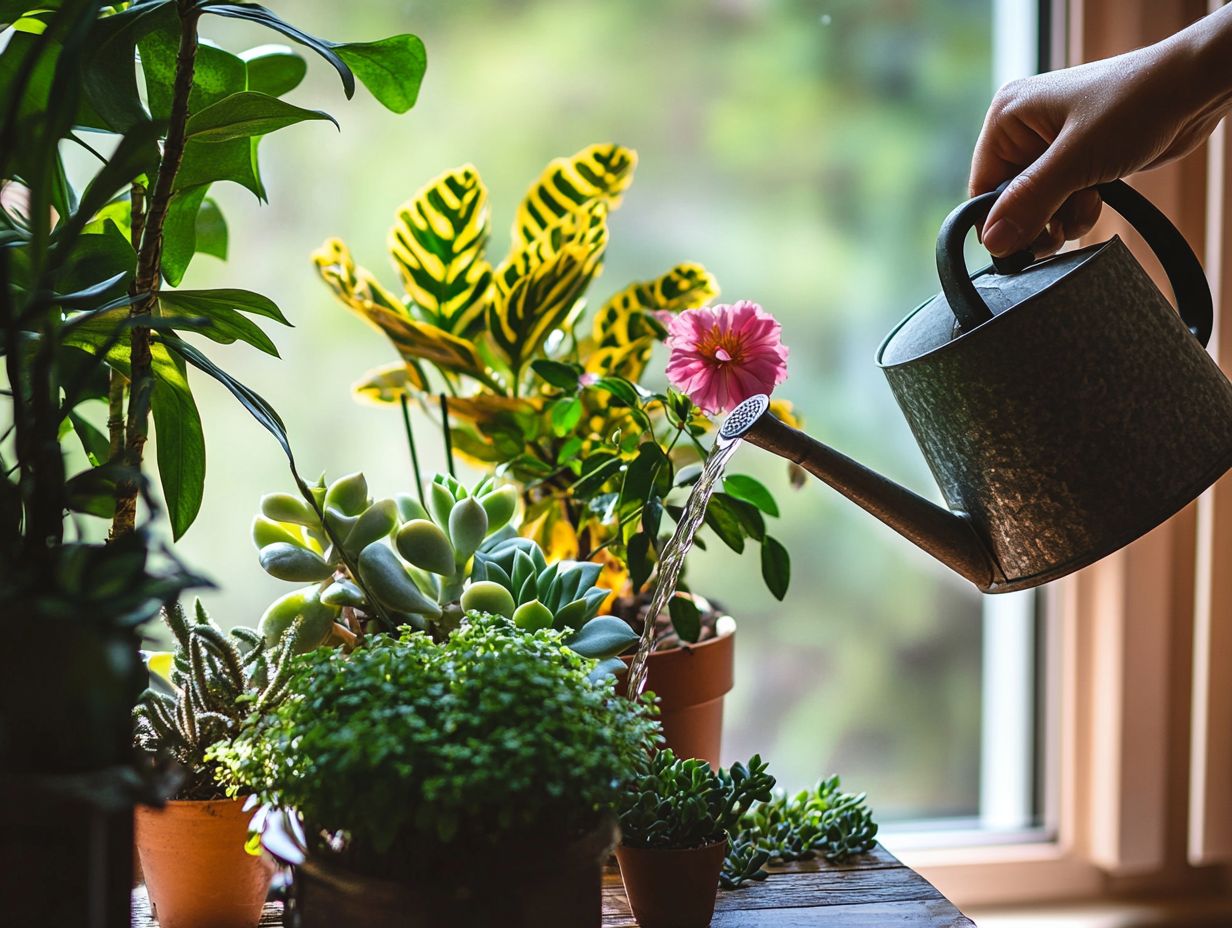
When caring for your flowering plants, employing effective watering techniques can greatly enhance their health and blooming potential. Using a watering can allows you to deliver moisture with precision, ensuring each plant receives just what it needs.
Regularly checking the moisture levels in the soil is essential. Insert your finger about an inch into the soil to easily determine when it’s time to water. For more information, consult the best practices for indoor plant care. Be vigilant about avoiding water accumulation in the pot, as this can lead to root rot and other issues.
Tailor your watering approach to the growth stages of each plant. For example, when caring for ferns, refer to the watering techniques for ferns, as newly planted seedlings often require more frequent, gentle watering, while established blooms thrive on less frequent but deeper soaks. Understanding these nuances can transform your garden into a vibrant tapestry of flowers.
Signs of Over and Under-Watering
Recognizing the signs of overwatering and underwatering is essential for maintaining your plants’ health. Both conditions can significantly impact foliage and overall growth.
Overwatering typically presents itself through yellowing leaves, root rot, and a soil texture that feels mushy. Underwatering, on the other hand, may lead to wilting, dry leaves, and stunted growth.
By understanding how to identify these signs, you enable yourself to make timely interventions and fine-tune your care routines accordingly.
How to Identify and Address Watering Issues
Identifying and addressing watering issues requires a systematic assessment of your plants’ conditions, soil moisture, and the strategic use of devices that measure how wet or dry the soil is (moisture meters) for accurate hydration measurement.
Regularly checking the soil s moisture content helps you easily determine whether your plants need a drink or have been overindulging. For example, if you notice the foliage starting to yellow or droop, those are often telltale signs of overwatering. If you see crispy leaves or wrinkled stems, it s a good indication that your plant is thirsty and needs some hydration.
Utilizing devices that check humidity levels (hygrometers) can give you deeper insight into humidity levels, which play a significant role in your plants’ watering needs. Once you’ve interpreted these diagnostic signs, you can jump into action and adjust your watering schedule or improve drainage by understanding the best way to water indoor plants to ensure your plants thrive in a perfectly balanced environment.
Frequently Asked Questions
What are the best watering techniques for succulents?
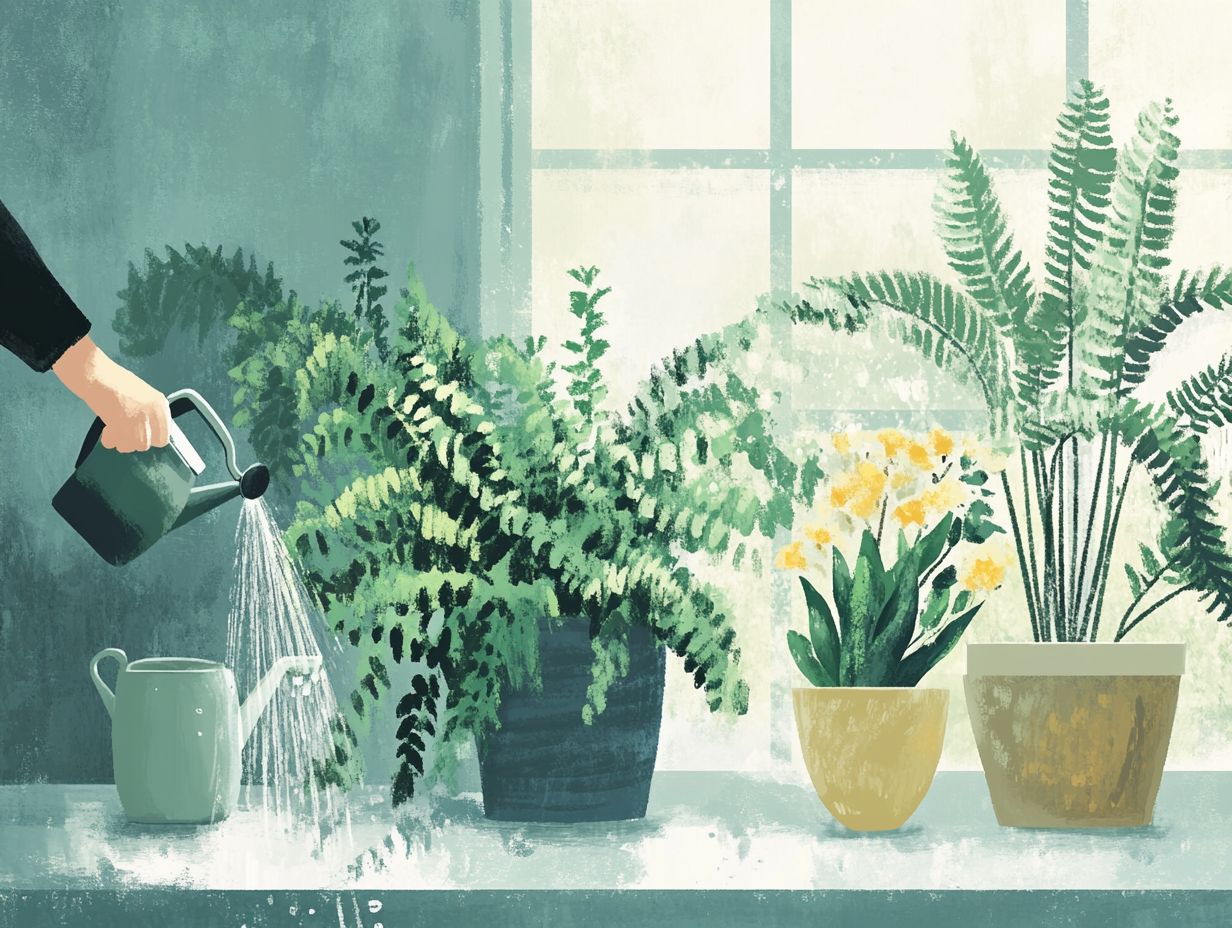
Succulents should be watered sparingly, allowing the soil to completely dry out between waterings. Avoid overwatering, as this can lead to root rot and other issues.
How often should I water my ferns and other indoor plants?
Keep ferns soil consistently moist but not soggy. Water once a week, but adjust based on your home s humidity and temperature!
Is it better to water cacti from the top or bottom, and what about other houseplants?
Cacti should be watered from the top, soaking the soil until excess water drains out the bottom. Avoid watering from the bottom, as this can lead to rot and fungal growth.
What is the best time of day to water indoor plants?
The best time to water indoor plants is in the morning. This allows the water to be absorbed and used by the plant throughout the day, and any excess can evaporate before cooler evening temperatures.
How can I tell if I am overwatering my indoor plants or underwatering them?
Signs of overwatering in indoor plants include yellowing or wilting leaves, mold or fungal growth, and a musty smell. Always check the soil moisture level before watering and adjust your schedule accordingly.
Do different indoor species like air plants, Dracaena marginata, and others have different watering needs?
Yes, different indoor species have different watering requirements. Make sure to check the watering needs for each plant type, taking into account the environment and conditions in your home.
Proper watering techniques are crucial for maintaining the health of your plants. Don t wait! Start implementing these practices today to ensure your plants thrive!

